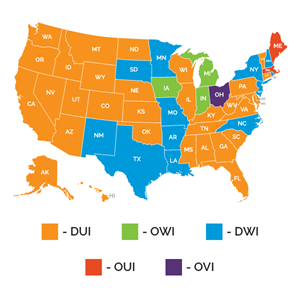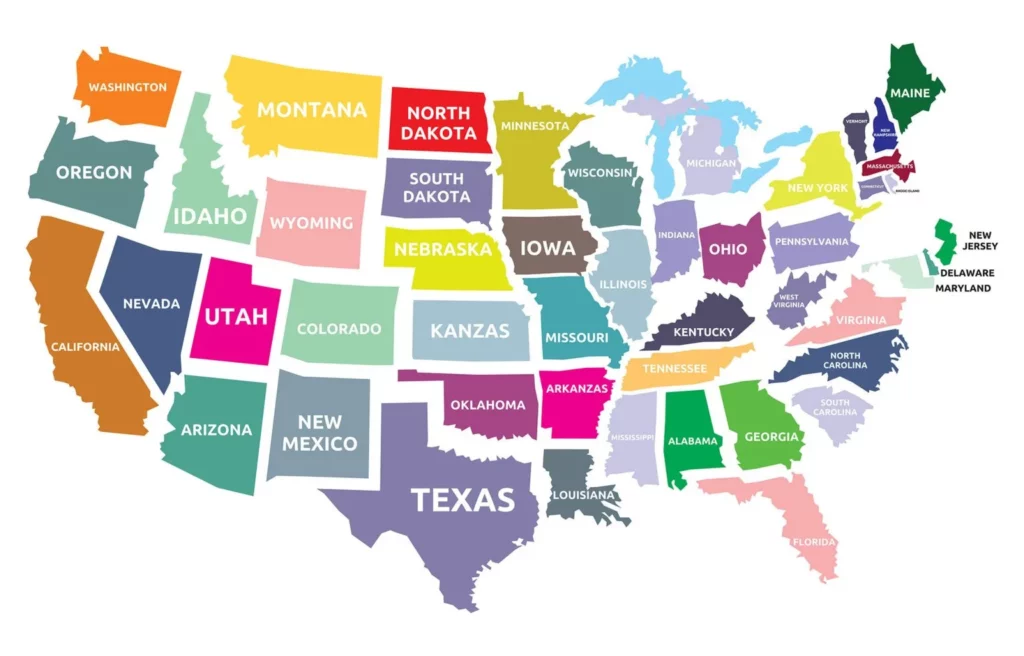Driving under the influence (DUI) is a serious public safety concern with severe consequences.
This article aims to examine DUI-related laws across different states through a comparative analysis, highlighting the variations and similarities in their legislative approaches.
By doing so, it seeks to evaluate the effectiveness of these laws in reducing DUI incidents and identify potential improvements for enhancing road safety.

Understanding Different DUI Terminologies
| Term: | Explanation: |
|---|---|
| OUI | Operating Under the Influence – Operating a vehicle under the influence of alcohol or drugs. |
| OVI | Operating a Vehicle Impaired – Similar to DUI, but includes any vehicle and emphasizes impairment. |
| OVUII | Operating a Vehicle Under the Influence of an Intoxicant – Similar to DUI, with a specific mention of ‘an intoxicant’. |
| DWI | Driving While Intoxicated/Impaired – Often used interchangeably with DUI; in some places, it specifically refers to alcohol impairment. |
| OMVI | Operating a Motor Vehicle Impaired – Specific to the operation of motor vehicles under impairment. |
| DWAI | Driving While Ability Impaired – A lesser charge than DUI/DWI, typically for cases where impairment is present but below the DUI legal limit. |
| DUII | Driving Under the Influence of Intoxicants – Addresses driving under the influence of any intoxicants, including alcohol, drugs, and prescription medication. |
Operating Under the Influence (OUI)
Operating Under the Influence (OUI): Legal Definition and Nuances
The term “Operating Under the Influence” (OUI) is a legal term used in some states to describe the offense of controlling or operating a vehicle while under the influence of alcohol or drugs.
The critical aspect of OUI lies in the term “operating,” which encompasses a broader range of activities than just driving.
It may also include situations where an individual is in physical control of the vehicle, even if it’s not moving.
This definition aims to prevent intoxicated individuals from being in a position to drive instead of only punishing the act of driving while impaired.
The legal limit for OUI usually involves a specified Blood Alcohol Concentration (BAC), but it can also depend on observable impairment or the presence of drugs in the system.
Operating Under the Influence (OUI): States and Specific Laws
The term OUI (Operating Under the Influence) is mainly used in states such as Massachusetts, Maine, and Rhode Island, each with its unique set of laws and penalties related to the offense.
In Massachusetts, the OUI laws are strict, and the penalties for the offense can include fines, license suspension, and even imprisonment, based on the severity of the offense and the number of prior convictions.
Maine follows a similar approach to OUI, where repeat offenders or cases involving aggravating factors like extremely high BAC levels can lead to substantial fines, license suspension, and even jail time.
Rhode Island also enforces strict OUI laws and mandates participation in alcohol or drug education programs for offenders.
It’s important to note that these states may have differences in how they interpret the “operation” of a vehicle and enforce the associated laws despite sharing the OUI terminology.
Operating a Vehicle under the Influence (OVI)
Operating a Vehicle under the Influence (OVI): Definition and Legal Implications
The term “Operating a Vehicle under the Influence” (OVI) is used in some states to describe the act of driving any vehicle, including bicycles and other non-motorized modes of transportation, while under the influence of drugs, alcohol, or both.
OVI laws are broader than traditional DUI laws and can result in severe legal consequences, such as fines, license suspension, mandatory alcohol education programs, and even imprisonment.1
The level of impairment required for an OVI charge varies depending on a person’s blood alcohol concentration (BAC) levels or demonstrated impairment while driving.
OVI laws aim to prevent people from driving while impaired, thus promoting road safety and reducing the risks associated with impaired driving.
Operating a Vehicle under the Influence (OVI): Comparison of States Using OVI
In Ohio, the term OVI is used to refer to impaired driving offenses.
Compared to other states that use different terms like DUI or DWI, the legal framework has some interesting differences.
Ohio’s OVI laws cover a broader range of vehicles and types of impairment, including drugs, alcohol, or a combination of both.
On the other hand, states that use DUI as a term may focus more narrowly on motor vehicles and alcohol impairment.
In Ohio, penalties for OVI escalate with repeated offenses or higher levels of impairment.
It’s worth noting that although all states penalize impaired driving, the specifics of the law, such as the allowable BAC levels, permissible evidence types, and the severity of penalties, can differ significantly, reflecting different legislative priorities and approaches to road safety.
Operating a Vehicle Under the Influence of an Intoxicant (OVUII)
Operating a Vehicle Under the Influence of an Intoxicant (OVUII): Explanation and Differences
The term “Operating a Vehicle Under the Influence of an Intoxicant” (OVUII) is primarily used in Hawaii to describe the act of operating any vehicle while impaired by alcohol or any other substance that can impair driving ability.2
This includes illegal drugs, prescription medications, and over-the-counter substances.
OVUII is distinct from other commonly used terms like DUI or DWI, which typically only refer to alcohol impairment and may not include other substances.
OVUII acknowledges the growing concern of drug-impaired driving and covers a broad range of substances that can affect a driver’s ability to operate a vehicle safely.
By encompassing a wide variety of intoxicants under the OVUII law, it shows a comprehensive approach to addressing impaired driving.
Operating a Vehicle Under the Influence of an Intoxicant (OVUII): State-Specific Laws and Penalties
The laws and penalties associated with this offense are stringent in Hawaii.
The state imposes severe consequences for OVUII offenses, which can include significant fines, license revocation, mandatory participation in alcohol and drug education programs, and even potential jail time.
The severity of the penalties often depends on factors such as the level of intoxication, the presence of minors in the vehicle, and the offender’s history of similar offenses.
Hawaii’s approach to OVUII also includes an implied consent law, where drivers are assumed to have given consent to a breath, blood, or urine test if suspected of OVUII.
Refusal to comply with testing can result in additional penalties.
The state’s comprehensive approach to OVUII aims to reduce impaired driving incidents and enhance overall road safety.
It acknowledges the varied substances that can impair driving and treats them with the seriousness they deserve.
Driving While Intoxicated (DWI)
Driving While Intoxicated (DWI): Understanding and Legal Scope
The term “Driving While Intoxicated,” or DWI, is used in many places to describe the criminal act of driving a motor vehicle while under the influence of drugs or alcohol.
While the term DWI usually refers to impairment caused by alcohol, it can also encompass drug impairment in certain situations.
The legal definition of DWI is often based on the driver’s blood alcohol concentration (BAC) level.
If the driver’s BAC level exceeds the legal limit (which is usually 0.08% in many states), they are considered legally impaired.
However, in some states, a driver can be charged with DWI based on observable signs of impairment, regardless of their BAC level.
The DWI charge reflects the legal system’s commitment to discouraging driving under the influence, recognizing its significant risks to public safety.
Penalties for DWI can be severe, including fines, license suspension, mandatory education programs, and even imprisonment, particularly in cases of repeated offenses or where impaired driving leads to accidents or injuries.
Driving While Intoxicated (DWI): Analysis of States with DWI Laws
Different US states use different terms for impaired driving, each with its unique approach to these laws.
For example, Texas has stringent DWI laws with penalties that escalate with repeated offenses, and a BAC of 0.15% or higher can lead to harsher punishments.
In New York, DWI and the lesser charge of Driving While Ability Impaired (DWAI) are distinguished, with DWAI applicable in cases of lower BAC levels.
New Jersey imposes penalties such as ignition interlock devices for DWI convictions and has strict laws for DWI in school zones.
These legal nuances reflect differing legislative responses to impaired driving.
While the fundamental principle behind DWI laws remains consistent – penalizing and deterring impaired driving – the specific legal frameworks, enforcement strategies, and penalties vary, demonstrating each state’s unique approach to addressing this critical public safety issue.
Operating a Motor Vehicle while Impaired (OMVI)
Operating a Motor Vehicle while Impaired (OMVI): Detailed Look and Legal Connotations
Driving a vehicle while under the influence of alcohol, drugs, or a combination of both, to a degree that hinders the driver’s ability to operate the vehicle safely, is commonly referred to as Operating a Motor Vehicle while Impaired (OMVI).
The term OMVI is specifically used to refer to the operation of motor vehicles such as cars, trucks, and motorcycles.
Laws relating to OMVI, like other DUI-related offenses, are designed to reduce the risks associated with impaired driving.
The legal implications of OMVI involve assessing the driver’s level of impairment, usually determined through blood alcohol concentration (BAC) levels or observable signs of impairment.
Some states enforce OMVI laws with particular BAC thresholds, while others rely more on law enforcement officers’ observations and field sobriety tests.
Penalties for OMVI may include fines, license suspension, mandatory educational programs, and imprisonment, particularly in cases of repeat offenses or where the impairment leads to accidents or injuries.
Operating a Motor Vehicle while Impaired (OMVI): Comparison of Laws in Different States
The laws related to Operating a Motor Vehicle Impaired (OMVI) can differ across states depending on their legislative approaches to handling impaired driving.
In some states where OMVI is the prevalent term, such as Ohio, the laws are designed to cover a wide range of impairment sources, including both alcohol and drugs.
Typically, the legal framework in such states includes a set BAC limit, above which a driver is considered legally impaired.
Moreover, the penalties escalate based on the severity of the offense and the presence of aggravating factors, such as repeat offenses or the involvement of minors.
When comparing OMVI laws across states, differences in enforcement practices, BAC thresholds, and imposed penalties may be noticed.
Some states might have stricter OMVI laws with lower BAC limits and more severe penalties, while others may focus more on rehabilitating and educating offenders.
The comparison highlights the varying degrees of emphasis placed on deterrence, punishment, and rehabilitation in different states’ responses to the challenge of impaired driving.
Driving While Ability Impaired (DWAI)
Driving While Ability Impaired (DWAI): Exploration, Definition, and Legal Standing
DWAI (Driving While Ability Impaired) is a legal term used in several jurisdictions, primarily in Colorado and New York, to describe a driving offense that is generally considered less severe than DUI (Driving Under the Influence) or DWI (Driving While Intoxicated).
DWAI specifically refers to a situation where the driver’s ability to operate a vehicle is impaired by alcohol or drugs but to a lesser extent than what is legally defined as intoxication.
For instance, in some states, DWAI may apply when a driver’s blood alcohol concentration (BAC) is above the legal limit for regular driving but below the threshold for a DUI or DWI charge.
The legal standing of DWAI acknowledges that even a minor impairment can significantly affect driving abilities, posing a risk to public safety.
DWAI charges frequently result in penalties that are less severe than those for DUI/DWI, such as fines, potential imprisonment, and driving restrictions or license suspensions.
Driving While Ability Impaired (DWAI): State-by-State Analysis
The application and enforcement of DWAI laws vary considerably from state to state.
For example, in Colorado, drivers can be charged with DWAI even if their BAC is as low as 0.05%, which is below the standard DUI threshold of 0.08%. Penalties for DWAI in Colorado include fines, points on the driver’s license, and possible jail time, with increased severity for repeat offenses.3
Similarly, in New York, DWAI applies to cases where the driver’s impairment is less severe than that required for a DUI charge, with the state outlining specific penalties such as fines, jail time, and mandatory education or treatment programs.
These state-specific laws recognize that impairment can begin before reaching the higher BAC levels associated with DUI/DWI and highlight the need for legal measures to discourage and penalize any level of impaired driving.
By comparing DWAI laws across states, one can observe the differences in how jurisdictions define impairment, enforce the laws, and structure penalties, revealing diverse approaches to addressing the nuanced issue of impaired driving.
Driving Under the Influence of Intoxicants (DUII)
Driving Under the Influence of Intoxicants (DUII): Legal Interpretation
“DUII” stands for “Driving Under the Influence of Intoxicants”.
It refers to the act of driving while impaired by any intoxicating substances, which include alcohol, illegal drugs, prescription medications, and over-the-counter drugs that can impair driving abilities.
The term DUII encompasses a broader range of substances than just alcohol, which is commonly associated with DUI, and highlights the danger posed by other substances as well.
Legally, DUII charges are usually based on evidence of impairment, such as observable signs, field sobriety test results, or blood alcohol concentration (BAC) levels.
In some jurisdictions, impairment from certain drugs for which there are no legal limits may also be included, relying on officer observations and other evidence of impairment.
The legal interpretation of DUII is designed to address and prevent the wide range of impairments that can affect a person’s ability to safely operate a vehicle, thereby enhancing road safety and reducing the number of drug- or alcohol-related accidents.
Driving Under the Influence of Intoxicants (DUII): States and Legal Frameworks
The term DUII is commonly used in the state of Oregon, where strict laws are enforced to prevent impaired driving.
Penalties for DUII offenses in Oregon can include fines, license suspension, mandatory completion of an alcohol treatment program, and even jail time, depending on the severity of the offense and the driver’s history.
The state’s approach to DUII covers a wide range of intoxicants, reflecting its comprehensive stance against impaired driving.
Oregon has an implied consent law to enforce these laws, meaning drivers are assumed to have consented to breath, blood, or urine tests if suspected of DUII.
Refusal to undergo these tests can lead to additional penalties.
This comprehensive approach in Oregon reflects a broader trend in DUI-related laws to address the growing issue of substance use and its impact on road safety.
Although other states may have similar laws, they may use different terminologies, such as DUI or DWI, and there may be variations in how they define and penalize impairment from different intoxicants.
Blood Alcohol Content (BAC) Limits and Testing Procedures
Blood Alcohol Content (BAC) Limits for DUI Categories
Blood Alcohol Content (BAC) limits for DUI offenses vary across states in the US.
In most jurisdictions, the legal limit for standard DUI offenses is set at 0.08%.
However, there are lower thresholds for certain categories of drivers.
Commercial drivers, for example, are often subjected to a lower BAC limit of 0.04% due to the higher responsibility associated with operating commercial vehicles.
Moreover, underage drivers are subject to zero-tolerance laws in many states, with the BAC limit set at 0.01% or 0.02% for individuals under 21 years of age.
Some states also differentiate between DUI and lesser charges like DWAI (Driving While Ability Impaired), where a BAC level between 0.05% and 0.07% might apply.
These varying BAC limits reflect each state’s legal stance on impaired driving and its efforts to address different risk levels associated with various driver categories.
Methods and Legalities of BAC Testing Across States
The methods and legalities surrounding BAC testing vary across states.
There are different approaches and regulations in place.
Generally, breathalyzer tests are the most common method to determine BAC due to their non-invasive nature and immediate results.
Blood tests are more invasive but are often considered more accurate and are typically used in serious cases such as accidents or when a breathalyzer test is refused or impractical.
Urine tests are less common and generally considered less reliable.
Legally, most states operate under implied consent laws, which means that by driving, motorists implicitly agree to undergo BAC testing if suspected of impaired driving.
Refusal to submit to BAC testing can lead to various penalties, such as license suspension and fines, and can be used as evidence in DUI prosecutions.
The specifics of these laws and penalties for refusal vary from state to state, reflecting the different legal frameworks and enforcement strategies used to tackle impaired driving.
Penalties and Legal Consequences
Penalties for DUI Categories Across Different States
There is significant variation in DUI penalties across different states, reflecting distinct legal approaches.
For standard DUI offenses, penalties typically include fines, license suspension, and possible jail time, with the severity often escalating with higher BAC levels or repeat offenses.
For instance, some states impose harsher penalties for a BAC significantly above the 0.08% threshold.
Commercial drivers and underage drivers, who face lower BAC limits, often encounter stricter penalties in many states, emphasizing the higher stakes involved with commercial driving and the zero-tolerance policy for underage drinking and driving.4
Moreover, states like New York and Colorado have specific categories like DWAI, where penalties are less severe than for DUI but still carry significant consequences.
This comparative analysis highlights the spectrum of penalties imposed across states, underlining the universal commitment to deterring impaired driving while also showcasing the nuances in how each state addresses different levels of offenses.
Aggravating Factors and Enhanced Penalties in DUI Cases
DUI legislation includes aggravating factors and enhanced penalties that address circumstances that significantly increase the risk or severity of the offense.
These factors include having a very high BAC level, repeat offenses, causing accidents or injuries, having minors in the vehicle, and driving with a suspended license.
When these factors are present, enhanced penalties may be imposed, such as longer jail sentences, higher fines, extended license suspensions, mandatory alcohol treatment programs, and the installation of ignition interlock devices.
Some states have specific provisions for these aggravating factors, with legislation clearly outlining the additional penalties.
This approach reflects the legal system’s recognition of the varying degrees of severity of DUI offenses and its commitment to imposing appropriately stringent consequences for more grievous violations.
Enhanced penalties serve as a strong deterrent against particularly dangerous behaviors associated with impaired driving.
Rehabilitation and Prevention Programs
State-Mandated Rehabilitation Programs for DUI Offenders
State-mandated rehabilitation programs for DUI offenders are crucial in many jurisdictions’ efforts to combat impaired driving.
These programs aim to reduce the likelihood of repeat offenses by addressing the root causes of impaired driving.
Standard DUI offenses often require rehabilitation programs that involve alcohol or drug education classes, substance abuse treatment programs, and counseling.
The intensity and duration of these programs may vary depending on the severity of the offense and the individual’s history.
For instance, first-time offenders may attend short-term educational courses, while repeat offenders might undergo more extensive treatment programs.
In some states, participation in these programs may be a prerequisite for reinstating a suspended driver’s license or reducing other penalties.
The focus on rehabilitation signifies a shift towards not only punishing offenders but also helping them understand the risks of impaired driving and modify their behavior.
Preventative Measures and Education Programs in DUI Legislation
Various strategies are used in DUI legislation across different states to prevent impaired driving and educate drivers about its dangers.
Most states implement public awareness campaigns highlighting DUI’s risks and legal consequences.
Education programs, often targeting young drivers, are commonplace, emphasizing the importance of responsible driving behaviors.
Many states also incorporate DUI education into driver’s education courses, ensuring that new drivers understand the severity of DUI from the outset.
Additionally, some states have implemented school-based initiatives and community programs focusing on the broader social and health implications of impaired driving.
The comparison across states reveals a shared commitment to prevention.
However, the specific strategies may differ, with some states focusing more on awareness and education.
In contrast, others may emphasize stricter enforcement and legal deterrents, like sobriety checkpoints and increased police patrols during high-risk periods.
These preventative measures complement the legal framework, working collectively to reduce the incidence of DUI.
Ensuring Road Safety and Curbing Impaired Driving
After analyzing DUI-related laws and terminologies across different states, it is clear that there are significant variations in definitions, legal thresholds, and penalties.
This indicates different approaches to combat impaired driving across the United States.
Drivers need to be aware of their state’s specific laws and consequences, as ignorance of the law is not an excuse.
Lawmakers can use this information to consider potential reforms or enhancements to their state’s DUI laws.
Law enforcement agencies must enforce consistent enforcement and education strategies that align with their jurisdictions’ legal frameworks.
This comparative study can guide all stakeholders in their ongoing efforts to ensure road safety and reduce the incidence of impaired driving.
Are You Looking for DUI Services?
At Cornerstone Healing Center in Scottsdale, AZ, you can choose from various DUI Programs and Courses, including approved online classes, alcohol screenings, and DUI screening assessments that meet DMV and MVD requirements.
These online services provide the convenience of fulfilling DUI requirements from anywhere.
Additionally, Cornerstone guarantees to offer prices 10% lower than any other DUI service provider in Arizona!
However, it is not just about complying with the legal requirements; Cornerstone also prioritizes a holistic approach to alcohol addiction treatment, with the goal of achieving lasting recovery.
By focusing on legal obligations and personal well-being, Cornerstone provides comprehensive support to help you get back on track.
Contact us today for a free evaluation and start your path to healing!










